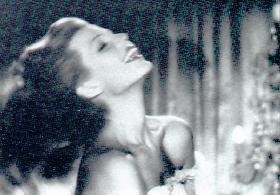FILM COSTUME - WOMEN IN FILM NOIR
Series in 5 parts
2 - IT’S A MATTER OF STYLE: RITA HAYWORTH in GILDA.
GOOD BAD GIRL
GILDA by Charles Vidor (1946) uses the stereotype of the GOOD BAD GIRL, a completely erotic idea of woman and - unlike the imported vamp - a typical American product. Above all the ambivalence of the character determines her feature.
„She is a good girl who appears to be bad ... The hero suspects that she is bad, but finally discovers this was a mistaken impression ... and in the end he can take here home and introduce to mother.“ (Martha Wolfenstein and Nathan Leithes, Movies)
The costume designer and his starNobody else but RITA HAYWORTH, the pin-up girl of the nation, embodies so much the mysterious matter which American dreams are made of. In a négligée as well as in an evening dress, in the boudoir as well as on stage: her appearances are deliberately produced and exciting - she sings, she dances, she smokes. An erotic inferno of style, styling, and the language of fashion. It was a French couturier who created the dress code for the GOOD BAD GIRL using the typical connotations of the femme fatale. JEAN LOUIS, the famous chief designer of Columbia Pictures (1944-58), then Universal, did the gowns for HAYWORTH in GILDA. These costumes are provocative and sexy, a hyper-feminine second skin for the object of desire - Hollywood’s costume design at it’s best.
THE DRESS CODE
The analysis will show: how the iconographic sign system forms itself, which individual components are able to communicate an illusion-creating effect, and how the usual code of fashion can be broken up.
Following a list of the applied costumes for the leading actress:
Négligée - evening dress - evening dress - day dress - négligée - costume of a Gaucho - home dress - skirted suit - evening ensemble - evening dress - evening dress - dancing costume - skirted suit - evening dress.The materials
In GILDA vestmental peculiarities are as natural as everyday life clothing. The fabrics flow: light-weight semi-transparent mousselines, super-tender silks, slicky satins, metallic paillettes, and voluminous furs establish an unmistakable feeling of luxury, attractiveness, and eroticism. The striking use of non-day clothing: numerous robes for the evening, dancing costume, négligée, carnival costume (Gaucho), deviates clearly from the conventional middle-class clothing of the 40s. On the other hand the costume which Gilda wears for her wedding is completely non-spectacular: a skirted suit of dark woolen cloth in the typical fashion style of the 40s.
© Rosa Burger, MA 1997
Tel. +43 1 535 94 09
FILM COSTUME - WOMEN IN FILM NOIR
Master’s thesis, University of Vienna, 1993.
FASHION TV -|||- FILM -|||- LINKS -|||- SHOPPING -|||- TexInfoSys -|||-CONTACT
